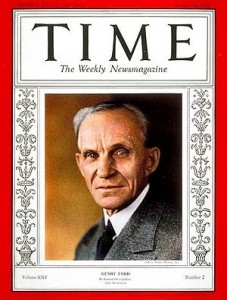 In 1970, GM employees went on strike for 67 days in the US and 95 days in Canada, the 400,000 workers lost $760 million in wages,and GM failed to produce 1.5 million vehicles resulting in a loss of $5 billion in profits. When Chrysler had a 104-day strike in 1950, Ford was able to overtake Chrysler. Strikes were devastating. In 1914, Henry Ford famously paid his workers $5.00 in order to create a middle class that could afford his automobiles. Today, the issue between United Auto Workers and management is not wages but fringe benefits. According to Lee Iacocca, the fault lies with management at Ford, GM and Chrysler who focused on expediency, profits for the next quarter and earning large bonuses for themselves instead of worrying about the long-term impacts of unsustainable benefits for union workers. Regularly, when the UAW threatened to strike, they played management hard and convinced them to accept their demands for better benefits so that short-term management goals could still be maintained.
In 1970, GM employees went on strike for 67 days in the US and 95 days in Canada, the 400,000 workers lost $760 million in wages,and GM failed to produce 1.5 million vehicles resulting in a loss of $5 billion in profits. When Chrysler had a 104-day strike in 1950, Ford was able to overtake Chrysler. Strikes were devastating. In 1914, Henry Ford famously paid his workers $5.00 in order to create a middle class that could afford his automobiles. Today, the issue between United Auto Workers and management is not wages but fringe benefits. According to Lee Iacocca, the fault lies with management at Ford, GM and Chrysler who focused on expediency, profits for the next quarter and earning large bonuses for themselves instead of worrying about the long-term impacts of unsustainable benefits for union workers. Regularly, when the UAW threatened to strike, they played management hard and convinced them to accept their demands for better benefits so that short-term management goals could still be maintained.
Management gave in on three areas that has effected the US auto-industry deeply. They gave in because they were focused on the short-term rather than the long-term objectives…
- The Cost-Of-Living Allowance (http://en.wikipedia.org/wiki/Cost_of_living): COLA causes run-away inflation since millions of autoworkers and regular Americans benefit from it because it pins the worker’s salary to the Consumer Price Index. Ironically, it was Charlie Wilson of GM’s idea in response to inflation when government lifted price controls in 1946. When the US was booming in the 1950s and 1960s the COLA was not an issue BUT when inflation soared as productivity declined the real problem was revealed.
 Thirty And Out: early retirement takes away qualified specialists and then leave the Big 3 to pay their $800 per month pensions (1984 numbers) while they sit at home being unproductive. In reality, the retired guy would work as a cab driver illegally on the side. This results in the best electricians ending up driving cabs. The policy was an UAW driven idea to make way for younger people to take on new jobs but the reality was people live longer than thirty years these days.
Thirty And Out: early retirement takes away qualified specialists and then leave the Big 3 to pay their $800 per month pensions (1984 numbers) while they sit at home being unproductive. In reality, the retired guy would work as a cab driver illegally on the side. This results in the best electricians ending up driving cabs. The policy was an UAW driven idea to make way for younger people to take on new jobs but the reality was people live longer than thirty years these days. Medical Benefits: the Big 3 pay $3 billion per year for hospitals, medical, surgical and dental insurance. This cost means $600 per car sold at Chrysler per year. Iacocca believes that there is immense abuse of the system where a podiatrist had charged Chrysler workers a total of $400,000 a year. There were over 240,000 blood tests done for only 60,000 employees.
Medical Benefits: the Big 3 pay $3 billion per year for hospitals, medical, surgical and dental insurance. This cost means $600 per car sold at Chrysler per year. Iacocca believes that there is immense abuse of the system where a podiatrist had charged Chrysler workers a total of $400,000 a year. There were over 240,000 blood tests done for only 60,000 employees.
For Iacocca, reforming and clawing back on union power and management weakness is imperative for the future of the US auto-industry. UAW never fought automation because it was a way to be more productive.


